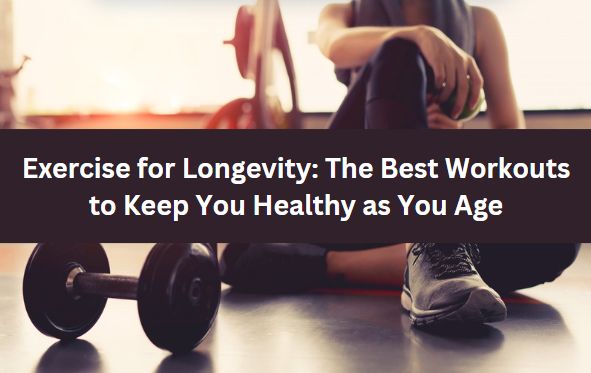Contents
Introduction
Exercise is a cornerstone of healthy aging, promoting physical, mental, and emotional well-being. As we age, regular physical activity becomes increasingly important to maintain mobility, strength, and independence. This guide explores the best workouts to keep you healthy as you age, helping you enjoy a long, active, and fulfilling life.
The Importance of Exercise for Aging
Physical Health Benefits
- Cardiovascular Health: Regular aerobic exercise strengthens the heart and improves circulation, reducing the risk of heart disease.
- Bone Density: Weight-bearing exercises help maintain bone density and prevent osteoporosis.
- Muscle Strength: Strength training preserves muscle mass, which naturally declines with age, and enhances functional abilities.
- Flexibility and Balance: Stretching and balance exercises reduce the risk of falls and improve overall mobility.
Mental Health Benefits
- Cognitive Function: Exercise stimulates brain health, improving memory, attention, and processing speed.
- Mood and Stress: Physical activity reduces stress, anxiety, and depression, enhancing overall mood and emotional well-being.
- Sleep Quality: Regular exercise promotes better sleep patterns and helps combat insomnia.
Social and Emotional Benefits
- Social Interaction: Group exercises and fitness classes provide opportunities for social engagement and community building.
- Self-Esteem: Achieving fitness goals boosts confidence and self-esteem.
The Best Workouts for Healthy Aging
Aerobic Exercises
Aerobic exercises, also known as cardio, increase heart rate and improve cardiovascular health.
- Walking: A low-impact, accessible form of exercise that can be done anywhere. Aim for brisk walking for at least 30 minutes a day, five days a week.
- Swimming: Excellent for cardiovascular health and joint health due to its low-impact nature. Swimming also improves muscle strength and flexibility.
- Cycling: Both outdoor cycling and stationary biking are effective for improving cardiovascular fitness and leg strength.
- Dancing: Fun and engaging, dancing improves cardiovascular health, balance, and coordination.
Strength Training
Strength training exercises build and maintain muscle mass, which is crucial for functional independence.
- Weight Lifting: Using dumbbells, barbells, or resistance machines to perform exercises like squats, lunges, and bicep curls.
- Bodyweight Exercises: Exercises such as push-ups, pull-ups, and squats that use your body weight for resistance.
- Resistance Bands: Portable and versatile, resistance bands are great for strength training at any fitness level.
Flexibility and Balance Exercises
Flexibility and balance exercises enhance mobility and reduce the risk of falls.
- Yoga: Combines stretching, strength, and balance exercises to improve overall flexibility and mental clarity.
- Tai Chi: A low-impact martial art that focuses on slow, controlled movements and deep breathing to improve balance and reduce stress.
- Pilates: Focuses on core strength, flexibility, and overall body alignment.
High-Intensity Interval Training (HIIT)
HIIT involves short bursts of intense exercise followed by periods of rest or low-intensity exercise. It can be modified for all fitness levels.
- Benefits: Improves cardiovascular health, boosts metabolism, and enhances muscle strength and endurance.
- Examples: Alternating between sprinting and walking, or performing a series of high-intensity exercises like jumping jacks and burpees followed by rest.
Creating a Balanced Exercise Routine
Frequency and Duration
- Aerobic Exercise: Aim for at least 150 minutes of moderate-intensity or 75 minutes of high-intensity aerobic exercise per week.
- Strength Training: Perform strength training exercises at least two days a week, targeting all major muscle groups.
- Flexibility and Balance: Include stretching and balance exercises in your routine at least two to three times a week.
Listening to Your Body
- Start Slow: Gradually increase the intensity and duration of your workouts, especially if you are new to exercise or have been inactive.
- Rest and Recovery: Allow time for rest and recovery to prevent overtraining and injury.
- Modify as Needed: Adapt exercises to your fitness level and any existing health conditions. Consult with a healthcare professional if necessary.
Staying Motivated
- Set Realistic Goals: Establish achievable fitness goals to keep yourself motivated and track your progress.
- Find Enjoyable Activities: Choose exercises and activities that you enjoy to make your fitness routine more enjoyable.
- Stay Consistent: Make exercise a regular part of your daily routine, just like eating and sleeping.
Tips for Safe Exercise as You Age
Warm-Up and Cool Down
- Warm-Up: Start with a gentle warm-up to prepare your muscles and joints for exercise.
- Cool Down: End with a cool-down period to gradually lower your heart rate and stretch your muscles.
Hydration and Nutrition
- Stay Hydrated: Drink plenty of water before, during, and after exercise.
- Balanced Diet: Fuel your body with a balanced diet rich in nutrients to support your exercise routine.
Monitoring Health
- Health Check-Ups: Regularly check in with your healthcare provider to monitor your health and address any concerns.
- Listen to Your Body: Pay attention to any signs of discomfort or pain and adjust your exercise routine accordingly.
Conclusion
Regular exercise is a key component of healthy aging, offering numerous physical, mental, and emotional benefits. By incorporating a variety of aerobic, strength, flexibility, and balance exercises into your routine, you can enhance your overall health and well-being as you age. Remember to start slow, stay consistent, and choose activities that you enjoy. With the right approach, exercise can help you maintain an active, vibrant, and fulfilling life well into your golden years.




